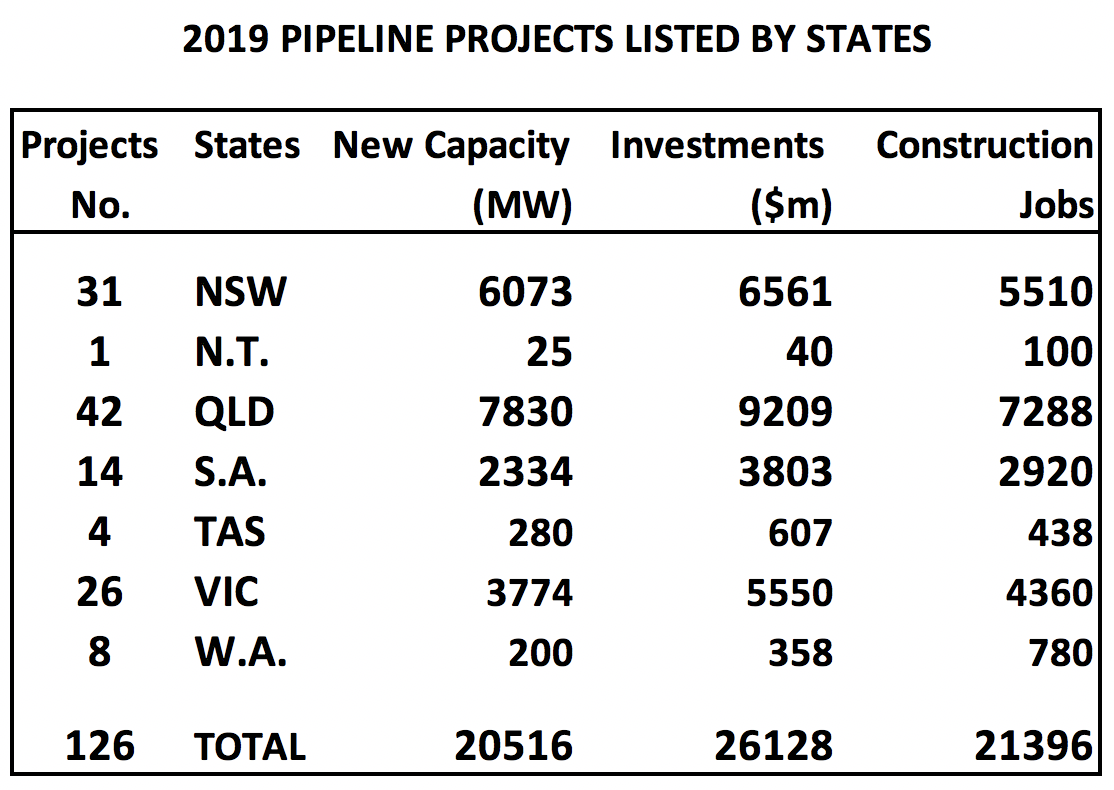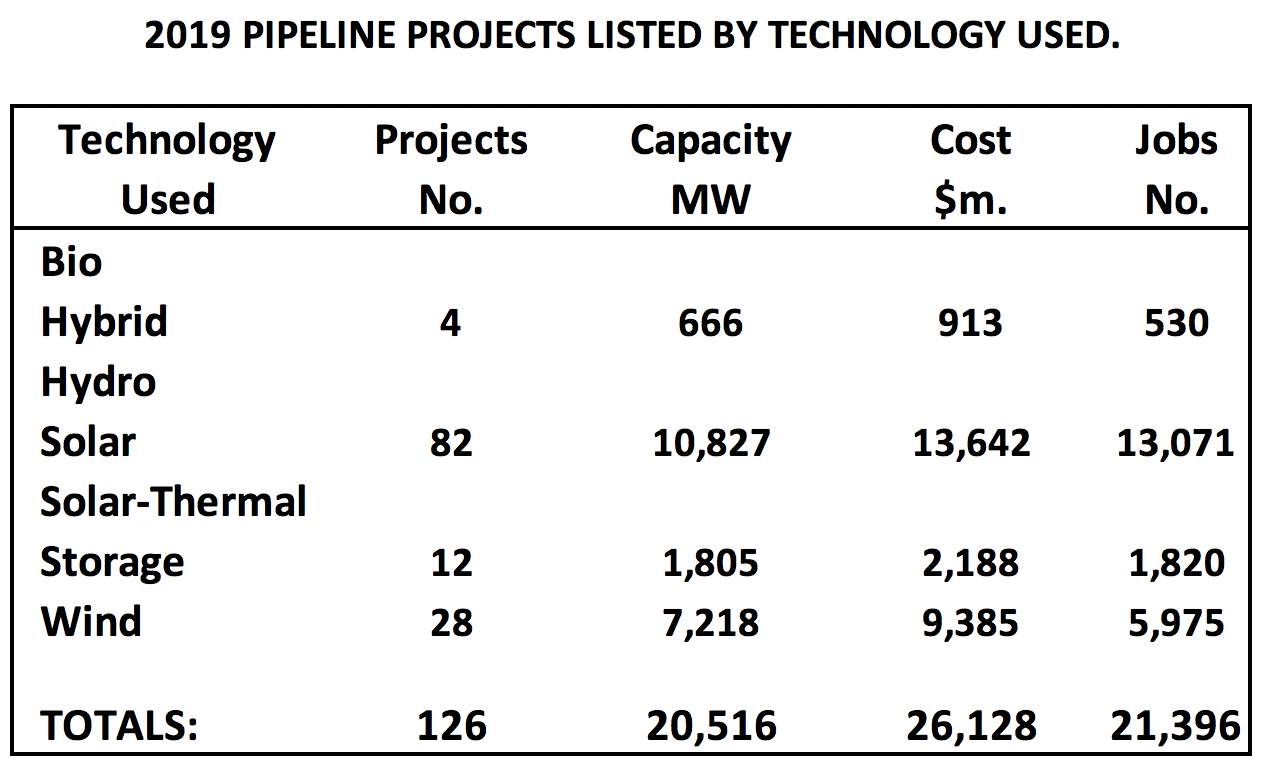
In a ‘Breakfast’ interview with Fran Kelly on ABC Radio National, the Australian Minister for Energy, Angus Taylor, made a number of statements which are either wrong or misleading. A record of the interview is available here.
1. The Minister claims that a ‘significant investment of $15 billion is being made in renewables’.
This is an understatement of over $11 billion. Fig. 1., shows that as at 1 January, 2019 State Governments and end-users had approved investment in 126 clean energy projects at an estimated cost of $26.1 billion, with new capacity to generate 20,516 MW of electricity.

Fig. 1. New Projects approved by Governments for construction. Most projects were under construction or are likely to commence in 2019. Source: Internet scans, Proponents advice and Clean Energy Council data.
2. The Minister asserts that Government target to reduce emissions by 26% (below 2005 levels) is a ‘strong target’ and one which will be met by 2022, a claim supported by the fact that we now have the lowest per capita emissions in 28 years.
Fran Kelly asked how could this be when data published by Government showed emissions in 2018 were rising. The Minister evaded the question with a misleading comment on per capita emissions.
The Minister knows (or should do) that both the Paris Accord and emissions causing global warming are measured in terms of ‘absolute’ not ‘per capita’ emissions and in absolute terms, Australia’s emissions are rising.
3. The Minister claims that ‘in the national electricity market we shall meet the 26% Paris target by 2022’.
To be a bit more accurate, the Paris Accord target is to reduce Greenhouse Gas emissions by 26-28% below 2005 remissions by 2030. The Minister claims this will be achieved by 2022. In theory this is possible - but unlikely. More likely is that the target could be reached by 2025, depending on growth in demand for electricity and the number of fossil fuelled power stations closed over the next 5-10 years.
The Ministers enthusiasm appears to be largely based on the size of the 2019 Pipeline of renewable energy projects which, as sown above, presently stands at around 20 GW and an investment of $26 billion. The speed with which these projects are likely to be completed may have been viewed optimistically. It may have been assumed that Pipeline Capacity will be routinely achieved which of course it will not be. More certain is that the Government will meet its Paris target before 2030.
4. The Minister asserts that ‘what we are not going to do’ is adopt a target of 45% reduction in emissions by 2030 (as the Australian Labor Party [ALP] have done) because economically this would be a wrecking target which would see Gladstone and Mackay shut down, the cement and aluminium industries shut down and the loss of hundreds of thousands of jobs.
The Minister has never publicly examined the adequacy of the 26% target in making a realistic contribution to reducing global emissions whereas the ALP appears to have done so, hence its much higher 45% reduction target. His claims about the effects of the 45% reduction target are totally unfounded and should be seen for what they are – hysterical rhetoric, unsupported by fact.
5.The Minister stressed the need to balance heavy investment in renewables with investment in energy which is available 24/7, that if we don’t get the balance right we won’t get lower electricity prices and reliability of supply. He was concentrating on ‘keeping the lights on’ and outcomes.
It is here that the Minister appears to make two fundamental mistakes:
(a) He fails to consider when blackout and need for power shedding occur. If they occur during daytime, the need is for increased generating capacity to meet a rising peak in demand – but if they occur during night-time, the need is for additional 'dispatchable' power, ability to supply more energy when solar panels are inactive - and that can be addressed using increased storage capacity and/or increased wind or hydro energy.
Loss of electricity supply in Victoria and S.A. occurred during the daytime when peak heat created high demand for air conditioning. What was needed to address this was increased generating capacity, which could have been provided from renewable sources, had they been available. They soon will be.
As shown in Fig 1 above, Victoria and South Australia (S.A.) State Governments have approved the building of 40 projects providing new generate capacity of over 6,000 MW to address this very issue. Victoria’s projects include 12 solar and 12 wind farms the latter able to generate over 2,000 MW with capacity to do so day or night.

Fig. 2. Solar and wind farms account for most new investment, with wind and storage able to provide 9,000 MW 'back-up' for solar. Hybrid projects comprise a mixture of solar, wind or biogas. Source: Internet scans, Proponents advice and Clean Energy Council data.
What the Minister did not mention (or know?) is that new projects likely to start in 2019 include new pumped water and battery storage, as shown in Fig 2, with capacity to store 1,800 MW which will also help eliminate power outages of the kind experienced by Victoria and S.A. during the January 2019 heatwaves when temperatures exceeded 40°C.
(b) The Minister fails to recognise that it is now cheaper to generate electricity from renewable sources, particularly wind, than from burning fossil fuels, with the possible exception of gas and that lower electricity prices can not be obtained by government subsidising private sector investment in fossil fuelled power stations. Taxpayers money could be used to subsidise electricity generated by fossil fuelled power stations but this is not the best use of public monies, since approved clean energy and storage projects can ensure future continuity of supply.
It takes around 5-6 years to build and commission a new fossil fuelled power station and about 3 years to refurbish an existing power station which is no longer commercially viable. In practical terms such a power station would not ‘come-on-line’ much before 2024, by which time technology advances will have been made in solar panel efficiency and electricity storage density which further reduce the cost of generating and storing electricity produced from renewable sources, making fossil fuelled generators even less competitive.
The Minister has indicated that to ensure continuity of electricity supply, Government is prepared to consider encouraging investment in uncompetitive generators by using taxpayers money to subsidise higher priced electricity sold by them. If implemented, this would be an inappropriate and unnecessary use of public monies since it would also be subsidising greenhouse gas emissions.
Conclusion:
The Australian Government and its Minister for Energy have long been suspected of seeking to promote new coal fired generating capacity, which of course increases greenhouse gas emissions and accelerates temperature rise. Having just endured the hottest January on record – with daily temperatures in some places nudging 50°C – and with a General Election to be held in May, the electorate is becoming increasingly concerned by the absence of government policy which effectively contributes to slowing climate change or dealing with its effects.
Most recently those effects have included reported loss of some 500,000 head of cattle in N.W. Queensland floods and over 1 million fish dead due to hypoxia in New South Wales rivers and lakes.
Australian and international banks will not lend to facilitate the building of fossil fuelled power stations in Australia. They know that such loans would be high risk, hence the government decision to consider public funding, subject of course to approval by both the House of Representatives and the Senate. Since the Government is in minority in both places, it is unlikely to gain the support it needs to proceed with measures which are viewed by the electorate with growing dislike.
The Energy Minister interview does little to ameliorate that dislike and nothing which is likely to gain support for the Coalition Government at the May election. Still, listen to the interview and make up your own mind.
Posted by Riduna on Tuesday, 12 February, 2019
 |
The Skeptical Science website by Skeptical Science is licensed under a Creative Commons Attribution 3.0 Unported License. |